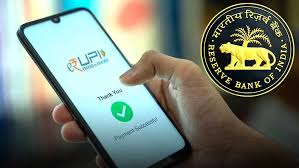RBI Allows UPI Payments via Third-Party Apps for PPI Holders
The Reserve Bank of India (RBI) has made a significant move by permitting Unified Payments Interface (UPI) payments via third-party applications for Prepaid Payment Instrument (PPI) holders. This initiative aims to enhance the ease of digital transactions and promote financial inclusion by expanding the scope of UPI-based payment systems to a wider range of users.
The move is set to impact millions of PPI users who previously had limited options for making UPI payments. By integrating third-party applications with the UPI network, the RBI seeks to increase the flexibility and accessibility of UPI transactions for all types of users, whether they are accessing their bank accounts or using PPIs linked to mobile wallets or other non-bank entities.
This decision will empower more individuals and businesses to use UPI seamlessly for daily transactions, even if they don’t have a traditional bank account. For example, mobile wallet services and prepaid cards will now be able to process payments via UPI, thereby extending UPI’s reach far beyond traditional banking customers.
In addition, this development is expected to stimulate the growth of fintech services and enhance the overall user experience for both consumers and businesses. The RBI’s move also aligns with its long-term goal of advancing a cashless economy by providing a secure and scalable platform for digital payments.

Why this News is Important
Enhancing Digital Payments Accessibility
The RBI’s move to allow third-party apps to facilitate UPI payments for PPI holders is a game changer in the realm of digital payments. The decision ensures that people using mobile wallets or prepaid cards can now leverage UPI, which has become one of India’s most popular and trusted payment methods. This increased accessibility is crucial in a country like India, where financial inclusion is a major challenge.
Promoting Financial Inclusion
By broadening the scope of UPI, the RBI is helping to bring financial services to underserved sections of society. Many individuals who do not have access to formal banking can now use their PPIs for UPI transactions, making it easier for them to engage in digital transactions. This will also encourage small businesses and vendors, who are more likely to rely on PPIs, to adopt UPI payments, fostering economic growth and inclusivity.
Strengthening India’s Digital Payment Ecosystem
This move strengthens the foundation of India’s digital payment ecosystem. UPI has already revolutionized payments in India, and expanding its usage to more individuals and businesses only increases its robustness. With the rise of digital transactions in various sectors, this will further encourage cashless transactions, making financial exchanges faster, safer, and more efficient.
Facilitating Convenience for Consumers and Businesses
For consumers, the ability to use UPI payments through third-party apps makes digital payments more convenient and widespread. Similarly, businesses benefit from this extension, as it reduces friction in payments and enhances the speed of transactions. This is particularly beneficial for micro and small enterprises that predominantly rely on PPIs and cash transactions.
Impact on the Fintech Industry
The RBI’s decision also has a major impact on the fintech industry, fostering innovation and competition among fintech companies. By incorporating third-party apps into the UPI framework, fintech startups can leverage this opportunity to reach new users and expand their customer base, offering a wider variety of financial services.
Historical Context
The Evolution of UPI
The Unified Payments Interface (UPI) was launched in 2016 by the National Payments Corporation of India (NPCI) to streamline digital payments in India. UPI allowed users to link their bank accounts and make real-time, peer-to-peer transactions, offering a fast and secure alternative to traditional payment methods. The platform gained widespread adoption, especially among tech-savvy consumers and merchants.
RBI’s Push for Digital Payments
The RBI has been a strong proponent of digital payments as part of India’s broader push towards a cashless economy. Over the years, the RBI has introduced various measures to make digital payments more accessible, secure, and affordable, including promoting the use of PPIs and strengthening the regulatory framework around digital transactions.
PPI Market Growth
Prepaid Payment Instruments (PPIs), such as mobile wallets and prepaid cards, have grown exponentially in India, especially in the digital era. They have become a vital tool for users who prefer cashless transactions but lack access to traditional banking. The introduction of UPI for PPIs represents a major leap forward in integrating these two modes of digital payments.
Key Takeaways from RBI’s Move on UPI Payments via Third-Party Apps
| S. No. | Key Takeaway |
|---|---|
| 1 | RBI’s permission allows UPI payments via third-party apps for PPI holders. |
| 2 | The move aims to increase financial inclusion by extending UPI’s reach to non-bank users. |
| 3 | Consumers can now use mobile wallets and prepaid cards for UPI transactions, promoting ease of payments. |
| 4 | This decision strengthens India’s digital payment infrastructure and promotes cashless transactions. |
| 5 | The growth of fintech services is expected, with increased competition and innovation in digital payments. |
Important FAQs for Students from this News
Q1: What is the significance of the RBI’s decision to allow UPI payments via third-party apps for PPI holders?
A1: The decision allows users of Prepaid Payment Instruments (PPIs) such as mobile wallets and prepaid cards to make UPI payments, thereby enhancing accessibility, promoting financial inclusion, and making digital transactions more flexible.
Q2: How will this decision impact the accessibility of digital payments?
A2: By integrating third-party apps with UPI, the decision makes digital payments accessible to a larger segment of the population, particularly those who rely on PPIs for transactions but do not have access to traditional bank accounts.
Q3: What are Prepaid Payment Instruments (PPIs)?
A3: PPIs are instruments such as mobile wallets, prepaid cards, and other digital wallets that allow users to store money digitally and make payments without requiring a bank account.
Q4: Why is financial inclusion important in the context of UPI payments?
A4: Financial inclusion ensures that all individuals, regardless of their socio-economic status, have access to financial services. Allowing PPIs to use UPI payments is a step toward integrating underserved populations into the formal financial ecosystem.
Q5: What role does the RBI play in digital payments in India?
A5: The RBI regulates and promotes the development of digital payment systems in India. It aims to create a secure, scalable, and efficient digital payment infrastructure, fostering the growth of cashless transactions across the country.
Some Important Current Affairs Links


















 Exciting News!
Exciting News!  Join Our Telegram Channel Now!
Join Our Telegram Channel Now!
 Join our Telegram channel for a thrilling adventure into the world of daily current affairs.
Join our Telegram channel for a thrilling adventure into the world of daily current affairs. 
 Don’t miss out on the latest updates and insights! Click to join now and be part of the knowledge revolution!
Don’t miss out on the latest updates and insights! Click to join now and be part of the knowledge revolution! 
